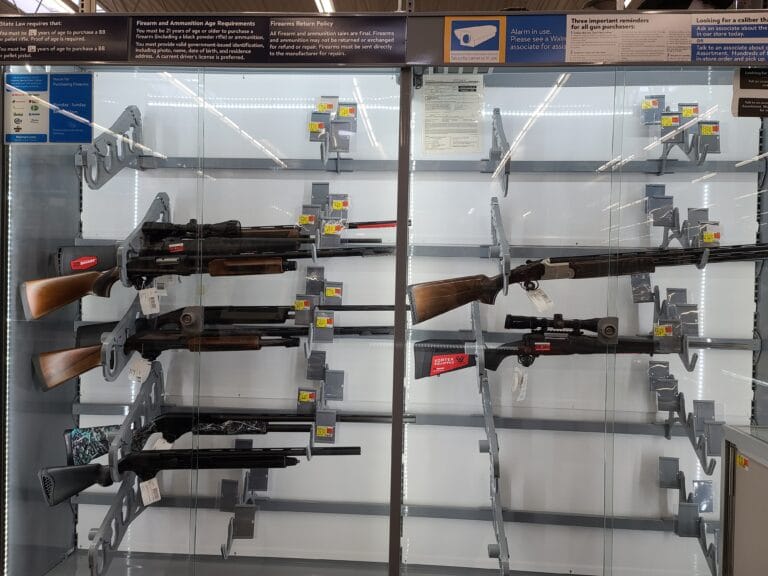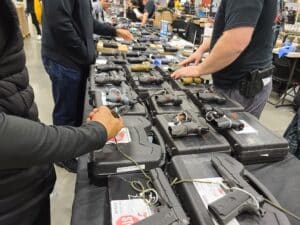16.4 million guns were sold in 2022.
That’s certainly a lot. But it’s actually a substantial decrease from the 18.5 million sold in 2021 and the 21 million sold in 2020.
Additionally, the two publicly-traded American gun companies have experienced corresponding declines in their sales. Ruger’s sales dropped to $139.4 million in its most recent quarter compared to $178.2 million and $145.7 million in the same quarter of the previous two years. Smith & Wesson saw an even more severe decline from $248.7 million between August and October 2020 to $230.5 million in 2021 and just $121.0 Million in 2022.
Ruger’s stock has fallen from a price high of about $87 per share at points in both 2020 and 2021 to $51 today. Smith and Wesson fell from a 2021 high of about $31 to about $9.
There are, of course, larger structural trends at play beyond the control of the gun industry or any other industry. Supply constraints have pushed prices up, and the resulting inflation has squeezed consumers to at least some degree. That’s led to lower demand and, combined with rising interest rates designed to fight that inflation, has put pressure on every company.
Lower demand has led to lower earnings and resulted in a general market downturn that has hit every sector.
Still, there are reasons to think the downturn may hit the gun industry particularly hard. For one, they’re coming off record-setting sales that saw millions of Americans buy guns for the first time. That’s a good thing for the industry in the long term, but it may be a drawback in the midterm.
It is extremely unlikely (hopefully) the next few years will produce the kind of motivating events for gun ownership the last few years have seen. I’d imagine most Americans who were potential gun owners going into 2019 have already become gun owners since then. That makes market growth a bit more challenging, especially with the general economic headwinds.
With the threat of the pandemic, rioting, and potential new federal gun restrictions waining, the typical downcycle the industry experiences in the wake of demand surges could be worse than usual.
There are also reasons to think the downturn won’t be so bad. For one, while 16.4 million sales is down a lot from 2020, it’s up a lot from the 13.2 million in 2019. It’s also still ahead of the 15.7 million sales in 2016, the previous all-time record.
The gun companies have also experienced this trend.
“A comparison back to […] the last period of normal firearm demand provides a great illustration,” Mark Smith, Smith & Wesson president, said in the company’s most recent earnings call. “This indicates that the temporary headwinds are being offset by longer-term tailwinds.”
Smith & Wesson’s most recent sales were up 6.4 percent compared to the same pre-pandemic quarter, and Ruger did even better with a 38 percent increase. While it may be hard to convert an above-average number of new gun buyers in the near term, a significant number of the millions who decided in the last two years are likely to keep buying. That means the new normal will is higher than the old.
With gun carry becoming far easier in many states, including populous blue states, thanks to the Supreme Court, there’s good reason to think demand will remain high relative to pre-pandemic years. Smith said Smith & Wesson has already seen evidence of this.
“As you’ll recall, there were more than 10 million new consumers added to the firearms market over the past 18 to 24 months, many of whom are now returning for subsequent purchases,” he said. “With these new entrants, previous studies indicating that firearms enthusiasts will own an average of seven to eight firearms and recent data showing that conceal carry is on the rise, we believe long-term demand trends remain very healthy.”
So, the industry is unlikely to collapse. It’s unlikely to see waves of layoffs or bankruptcies either since most experienced companies are designed to weather the feast-and-famine nature of the industry. Besides, what’s bad in the short or midterm for the industry isn’t always bad for gun owners generally.
Since the drivers of this downturn are, effectively, an increase in national stability from the lows of the last two years and the return of a divided federal government (ending whatever hope President Biden had for new gun bans), it would be pretty odd to lament it. It’s possible all of those trends could reverse themselves, but I’m not sure anyone would be happy to see it.
Plus, this sort of downturn is less likely to produce severe industry damage than it is to produce some really favorable deals for gun buyers. Smith & Wesson is certainly betting a price war is ahead.
“All of this means we remain in a highly competitive environment and winning profitable market share at the consumer level remains our core focus,” Smith said. “With many consumers squeezed by inflation and record prices for household essentials, consumer price sensitivity on discretionary purchases has increased, predictably, leading to increased promotional activity within the firearm space.”
Even from an investor’s standpoint, Ruger and Smith could represent a decent value. Certainly, if you bought at the peak, you’re having a very bad time. But, if you’re thinking of buying today, both stocks are near five-year lows despite much better sales than five years ago.
I have no idea what direction the market is headed or if a recession could push things much lower than today. For now, though, the market seems to be undervaluing them.
It’s far from clear 2022 represents the new bottom of the gun market. With how much cushion it still has over the pre-pandemic era and how the decline has slowed, it probably is a good representation of the new normal. So, there’s little reason for gun owners to be concerned.






